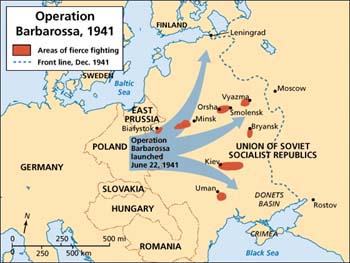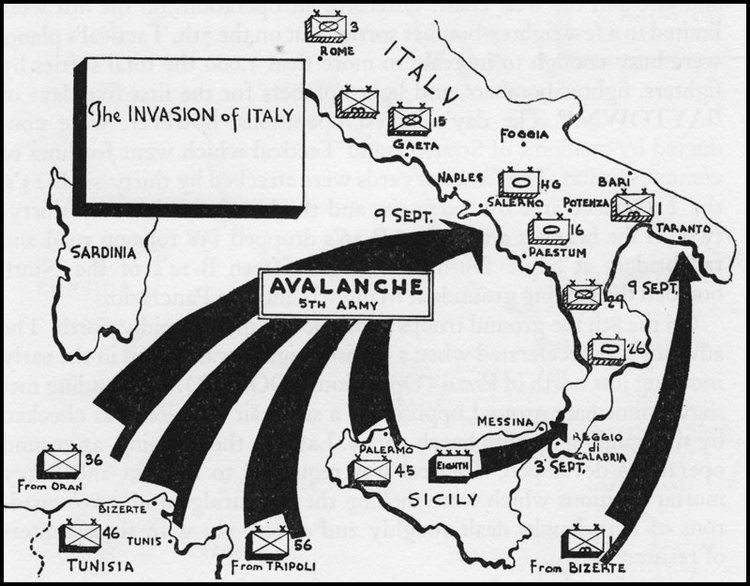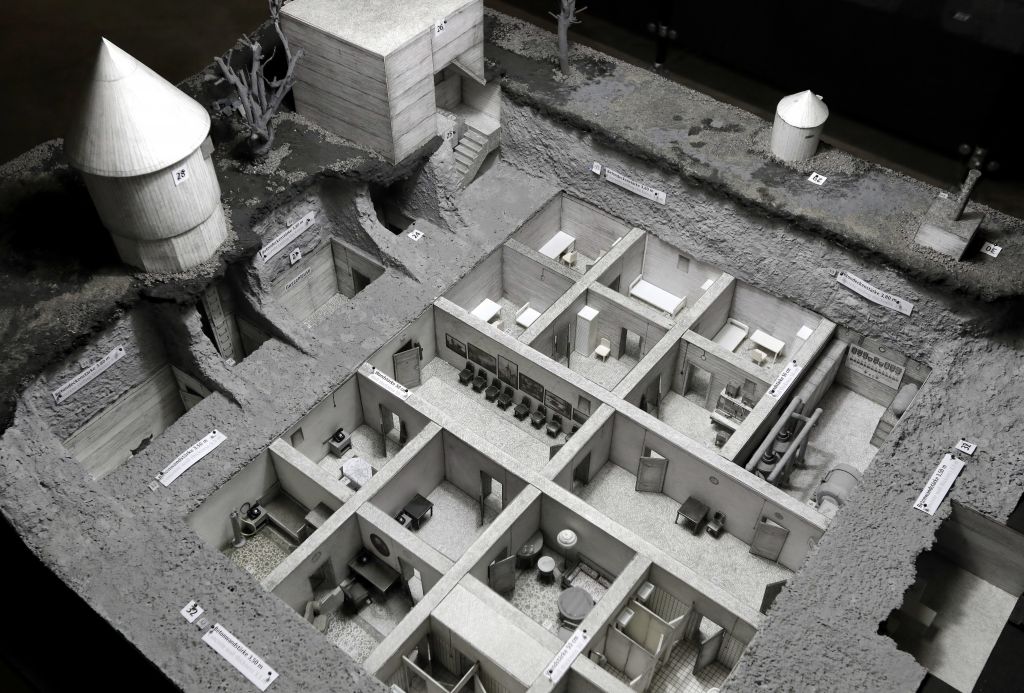Week 2: The Tide Turns; The End of the War In Europe

Soldiers fighting in the Battle of Moscow, 1941-1942
Welcome back! I hope that you had a nice long weekend (as nice as possible during a pandemic!) and that you were able to spend some time relaxing or with family.
What's the Focus for this Week?
This week we will be exploring the how the war in Europe unraveled for Hitler and Mussolini, and examining 'how the tide turned'. We will explore the last days of the war in Europe, and how it set the stage for Cold War tensions between the USA and the USSR.
This week we will:
- Briefly review the material from last week
- Explore Hitler's massive push to win the war - The War Spreads
- Explore the collapse of the Axis powers in Europe - The Tide Turns
What will you have to do?
- READ THE TEXT IN THIS BLOG POST, taking personal notes for yourself that you will use at the end of this unit. There are two specific tasks to do, plus optional videos and articles.
- Complete one LEARNING ACTIVITY that you will post on Teams by the end of the week. The focus will be on WWII movies/films/books.
Let's Begin...
Royal Canadian Air Force pilots racing to their planes, 1940
RECAP REVIEW: Last week we explored the first wave of WWII, which included Hitler fast and furious expansion across Europe, using Blitzkrieg tactics. We listened and read about the Battle of Britain - an attack on the United Kingdom that Hitler was forced to abandon because of a strong airforce defense by the RAF and RCAF, and the invention of radar. Britain was able to defend itself, with the help of Canadian pilots, and Hitler was pushed back. At this point though, Britain stood alone in Europe, the only 'European Allied force' left to fight the Axis powers.
THIS WEEK - SECOND WAVE OF WWII - 1941-42
Axis Forces Press On: The War Spreads
While abandoning Operation Sealion (the invasion of Britain) was a blow to Nazi Germany, it wasn't the end. Hitler and Mussolini continued major attacks in different places in the world.
PART 1 - THE WAR SPREADS: USSR

Operation Barbarossa was the code-name for Hitler's invasion of Russia. In June 1941, Operation Barbarossa began, setting off a bloodbath that was supposed to bring the Soviet Union to its knees. For four years, Operation Barbarossa tore through the Eastern Front – and though it began as the largest surprise attack in military history, it quickly became one of the world’s biggest and deadliest conflicts.
Despite Hitler’s hopes, the Soviet Union and its people refused to back down, altering the course of WWII and ultimately bringing Nazi Germany to defeat. The Russian path to victory wasn’t without great struggle, though; the Soviet Union was plagued with military losses, deaths, and even starvation of its people over the course of the operation.
KEY BATTLES:
Siege of Leningrad, Moscow, & Stalingrad
PURPOSE: Hitler
wanted access to the Caucasus Oil fields of the USSR, and to seize Leningrad
and Stalingrad and embarrass Josef Stalin.
OUTCOME: Hitler lost
his best units, the fiercest fighting took place in Stalingrad, and the Russians
practiced a ‘scorched earth policy’ which was incredibly difficult on the
Germans. Massive disaster. Following Stalingrad, the Germans were pushed
back by the Russians all the way to Berlin
TASK: Watch the following video about the Battle of Stalingrad (Start at 1:20min - ads at beginning). Answer the following questions:
- Why did Hitler divert the German army group southwards in the USSR - what did he need?
- What was the fighting like in the Battle of Stalingrad?
- Why were the Russians able to beat the Germans in this battle?
PART 2: THE WAR SPREADS - INVASION OF NORTH AFRICA - 1941-1943

WHO: Operation Torch began with Mussolini attempting to take control of North
Africa. Hitler was forced to come in as
back-up in order to support the Italian troops. Mussolini was viewed as a poor military strategist, and many viewed him as a liability for the Axis forces. Most of the Allies fighting in this theatre against the Axis powers were actually Americans, led by General Eisenhower. Battles were fought back and forth across North Africa.
PURPOSE: To gain access to the Suez region and Middle
East oil. Allies wanted to use North
Africa as a stepping stone to Europe.
They would cross the Mediterranean to Italy, and then make their way to
Berlin.
TYPE OF
FIGHTING: Tank fighting in deserts, bombing raids
OUTCOME: The Allies
won the Battle of El Alamein in 1942-43, securing North Africa. From there they attacked Sicily, and on to mainland
Italy.
OPTIONAL VIDEO - Interested in this topic - watch this video on German Erwin Rommel - the "Desert Fox" Lieutenant General who led the North African campaign for the Axis powers.
PART 3: The Tide Turns - the Collapse of Axis Powers
The losses in North Africa and the USSR would be devastating for the Germany and Italy. From these two locations, the Allies would change the direction of the war, and push back towards Berlin.
You probably have heard of D-Day - a major invasion of Hitler's "Fortress Europe" at the end of the war. It took over two years to prep for D-Day - 1942-1944 was spent building up military strength, strategy and territory.

But how did the Allies gain the military strength to win?
Step 1 ITALY : From North Africa, the Allies jumped to Sicily, and then to mainland Italy in Operation Avalanche. Canadians fought key battles in Ortona, Italy. The Allies viewed Italy as the "soft underbelly" (meant to be an insult) of the Axis powers - believed they were weaker and wanted to eliminate enemies in the south first before attacking northern France.
Mussolini was captured and executed by firing squad, his body hung upside down in an Italian square. He died not with glory, but rather with citizens berating his body. Read about his final days here - the reading on his death is gruesome. This brutal treatment greatly impacted Hitler, and informed his decisions about his final days, so that he could avoid capture. He was quoted as saying "that will never happen to me."
Step 2 D-DAY: Once the southern portion of Europe was liberated, and the Allies turned their attention to Operation Overlord - D-Day.
The Western Allies of World War II launched the largest amphibious invasion in history when they assaulted Normandy, located on the northern coast of France, on June 6, 1944. The invaders were able to establish a beachhead as part of Operation Overlord after a successful "D-Day,” the first day of the invasion.
Allied land forces came from the United States, Britain, Canada, and Free France. In the weeks following the invasion, Polish forces and contingents from Belgium, Czechoslovakia, Greece, and the Netherlands participated in the ground campaign; most also provided air and naval support alongside elements of the Royal Australian Air Force, the Royal New Zealand Air Force, and the Royal Norwegian Navy.
The Normandy invasion began with overnight parachute and glider landings, massive air attacks, and naval bombardments. In the early morning, amphibious landings on five beaches code named Sword, Juno, Gold, Omaha, and Utah began. During the evening the remaining elements of the airborne divisions landed. Land forces used on D-Day sailed from bases along the south coast of England. The fighting was brutal - the first 45 minutes of the movie Saving Private Ryan is based on this attack.

TASK: Watch the following video on D-Day: How the Allies Broke Through and answer the following questions.
1. How did the geography (water invasion, steep cliffs, etc.) affect the nature of the fighting on D-Day?
2. What strategic steps helped the Allies in their success on D-Day?
3. How would you describe the fighting in this battle?
STEP 3: RACE TO BERLIN
Once D-Day was won, the Allies (British and American) raced to Berlin, where Hitler was stationed. Canadian forces headed to Holland/Netherlands to liberate them from Nazi occupation. In the East, Russian forces raced to Berlin as well.

Soviet forces reached Berlin first, and they were in charge of negotiations with Nazi Germany. Hitler, along with his wife Eva Braun, would commit suicide in his underground bunker in Berlin as the Russian troops entered the city. Joseph Goebbels (Nazi Propaganda minister) and his wife would kill their 5 children, and then commit suicide as well. This left key Nazi officials to announce to the people that the Axis powers had lost the war.

Reconstruction of Hitler's underground bunker The couch where Hitler committed suicide
This time - there would be no question what the Allies would want from Germany. Complete, unconditional surrender was demanded by the Russians. They didn't want an end similar to World War I where Germany felt like they would receive fair treatment, or have reason to feel betrayed.
World War II was complete in Europe (the Pacific Theatre would still go on for another year!), yet tensions between the USA and the USSR were extreme. Stalin and Truman, leader of the USA, were not even on speaking terms by this point.
You're done! Got questions? This video summary of WWII might help. If not, move on to Learning Activity.
WEEK 2 LEARNING ACTIVITY: The Stories of World War II
Due on Sunday of this week. Post on Teams.
There are an enormous number of movies, books, memoirs and documentaries about World War II. Some of them are more historically accurate than others, but they are still collections of stories that help bring this momentous event to life.
A. WATCH OR READ - Watch a movie, documentary, or TV special OR read a book, article about World War II. Don't have alot of time this week? No problem - choose a short video clip, or watch only part of a movie
B. POST ABOUT IT ON TEAMS - WWII Stories Channel
Please ensure that you have proof-read your work, are using proper grammar like capitalization, and post directly on the page, rather than attaching your work. Provide an image if you'd like.
Please ensure that you have proof-read your work, are using proper grammar like capitalization, and post directly on the page, rather than attaching your work. Provide an image if you'd like.
1. Name the source that you watched/read. (ex. I watched the Hollywood movie Saving Private Ryan directed by Steven Spielberg).
2. Briefly describe 3-4 details about the real-life WWII event that your movie/book/documentary/film clip was based on. You might have to research this a bit.
2. Briefly describe 3-4 details about the real-life WWII event that your movie/book/documentary/film clip was based on. You might have to research this a bit.
3.. If you chose a Hollywood film or book, assess how accurate you think the movie/book, etc. is? Some of your movies may not be very historically accurate (ex. Pearl Harbour). If you chose a documentary, skip this question, and we will assume it's accurate.
4. Describe a powerful part of the book/movie/film clip that impacted you.
5. State a question that you have about this real-life historical event - what do you want to know more about?
SHORT FILM/DOC VIDEO OPTIONS: For those with less time, or less interest =) Choose your own (min 10min and should be RELIABLE AND ACCURATE) or one of these...
1. The man who fought without a weapon. - True story of Desmond Doss, a US medic in Pacific Theatre. Inspiration for film Hacksaw Ridge. 15 min.
3. Wondering about the origin of Anti-Semitism? The History of the Jews - Geo Channel
5. D-Day from a German perspective - Armchair Historian
6. Documentary of WWII (45min) - Top 5 Docs
FULL-LENGTH MOVIES - Feel free to choose your own source, but here are a few ideas as a start... NOTE - this is a unit about WWII, so many of these films will be intense. This is also just a short list.
1. Downfall (Der Untergung) - This is a German movie about the last days of Hitler's life. It's incredible - but only available on American Amazon. If you are able to find it online - watch it! Even just last 45 minutes. Sawatsky recommends!
2. The 12th Man (Netflix) - Movie based on real-life survival mission by a Norwegian spy. Suspenseful and inspiring.
3. Imitation Game (Netflix) - True story of Alan Turing and code-breaking - very little violence! =) Amazing story - great movie to watch with your family.
4. Darkest Hour (Netflix) - Story about Winston Churchill - early stages of the war, Battle of Britain
5. The Zookeeper's Wife (Netflix) - Based on true story of family that rescued Jews using the Zoo in Warsaw, Poland.
6. Hacksaw Ridge (Netflix) - Super violent, but based on the true story of a medic who fought without a weapon, in the Pacific theatre, in Okinawa.
7. The Pianist (Youtube) - Incredible movie (violent first hour) that tells the true story of a Polish Jew that was a professional pianist, and his survival of the Holocaust. Subtitles might be distracting in this version, but its free. Sawatsky recommends!
8. Saving Private Ryan (Youtube) - very violent first 45 minutes, but excellent movie. inspiring and sad story about a rescue mission of a soldier in Europe.
9. Life is Beautiful - my favourite movie about WWII - so wonderful - funny incredibly inspiring, just difficult to find online =) Sawatsky recommends!
10. My Way (Korean movie about WWII) - for those that love Korean media - here you go. It's supposed to be great!
11. Mission of Honour (Hurricane) (Netflix) - war in the skies. Haven't seen it but good reviews.
Some others that I haven't seen...
Stalingrad (Youtube) - Battle of Stalingrad from German perspective.
Dunkirk - can't find it online but you could buy or rent
U-571 - Good movie about Battle of Atlantic on Apple TV
Boy in Striped Pajamas
Fury (Netflix) -WWII tank drama with Brad Pitt
Books/Print: Just a couple to get you started, but any would do.
Maus graphic novel
All the Light We Cannot See - incredible book about two children on opposite sides of the war
The Boy in Striped Pajamas
The Diary of Anne Frank
Cryptonomicon
The Book Thief
Post on teams by the end of the week - or ask Ms. S for an extension. Hopefully you might be able to watch a movie with your family or siblings =)
Comments
Post a Comment